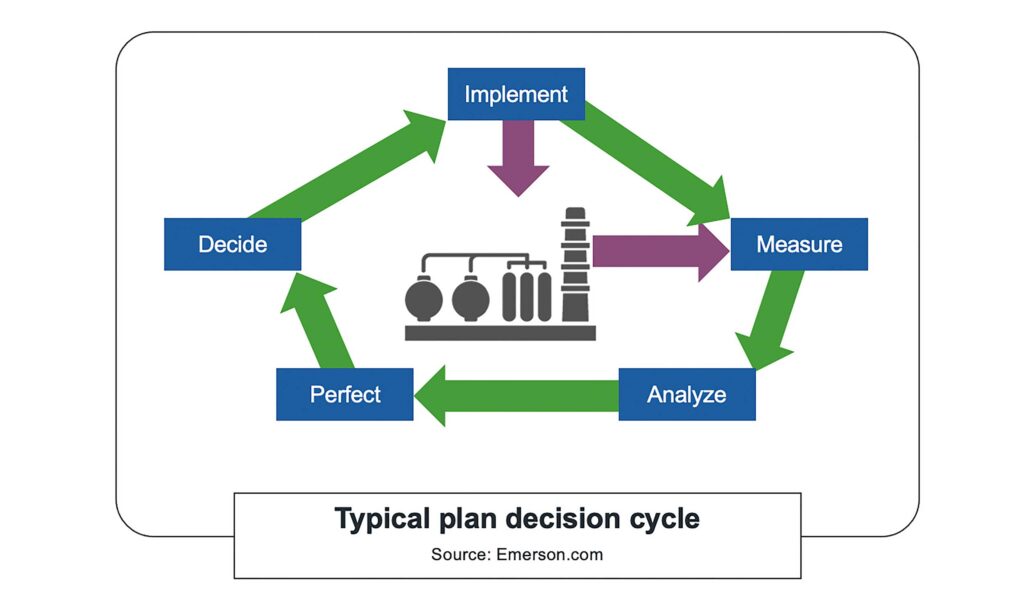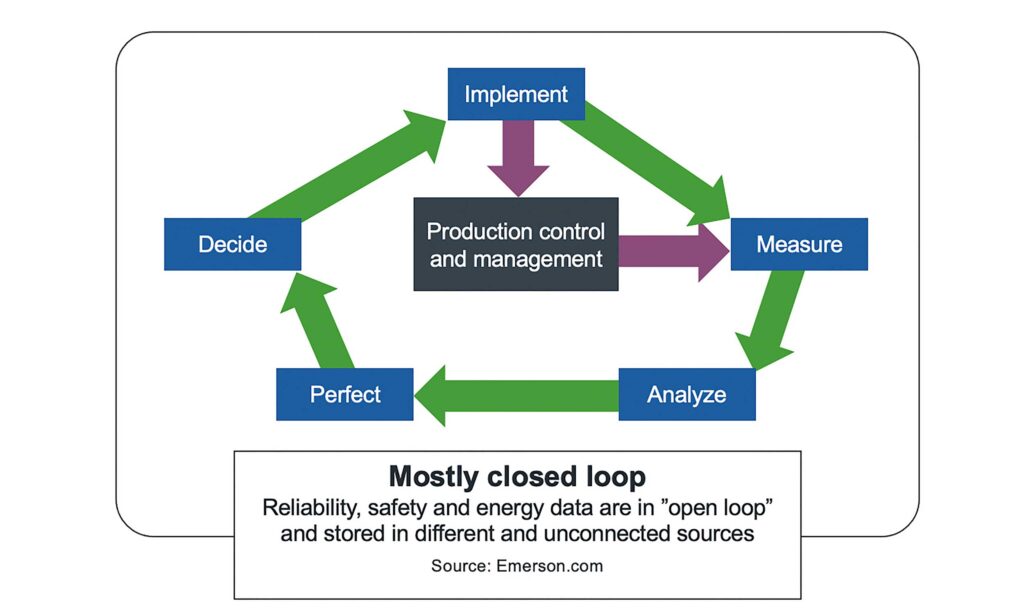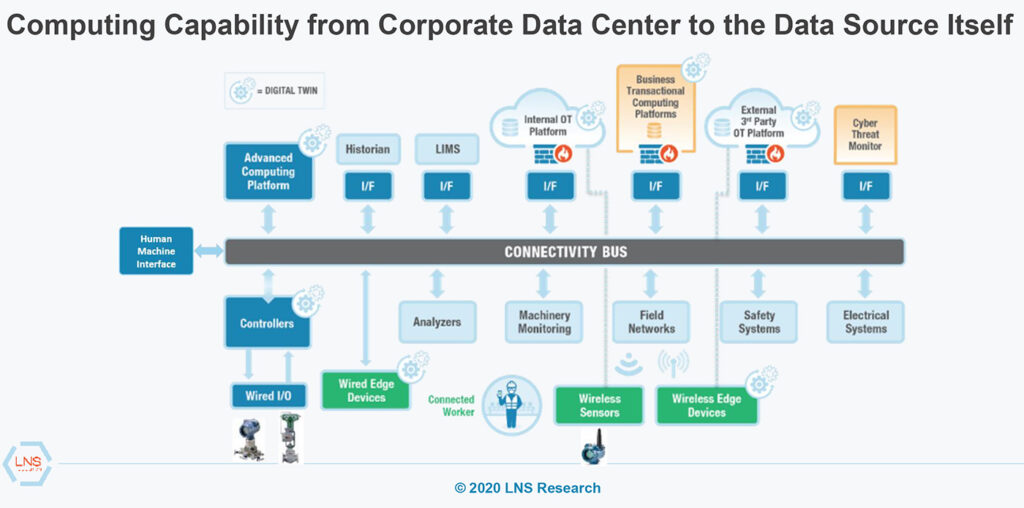Is your company’s digital intelligence stranded and unproductive? A robust information/data “scaffold” efficiently unlocks the flow of data and knowledge throughout the organization.
Companies are investing in digitalization projects to achieve major long-term goals, as listed in Table 1.1 The digital transformation essentially opens the flow of data (in various formats) and connects multiple sources to remote and on-site users. With advanced architectures and platforms, data and information transfer processes are faster. Consequently, operations and market data are business assets and have value. Quicker access to information is the end game. Many companies must answer: Is the optimum scaffold (platform) in place to support data flow and information availability (IA) throughout the organization?

Not all data are equal
Processing and manufacturing industries have amassed volumes of data but struggled to convert it into usable information. Digitalization projects are geared to improve analytics and provide predictive capabilities. Such efforts involve using digital twins, AI, machine learning (ML) and predictive maintenance (PdM). These methods require large quantities of quality data resources.
Table 1. Investment objectives for digital projects1
| Safety | Zero Accidents |
| Sustainability | Zero Significant events or releases |
| Availability/reliability | Zero Downtime/operations interruptions |
| Finance | Zero Lost profits |
Table 2. Major concerns over data
- Lack or insufficient data
- No or limited access to databases
- Corrupt data
- Missing/incomplete data
- Wrong (missing) format and tags between data sources
- Security issues
The ROI on digital programs is often measured against enhanced operations reliability and improved safety/environmental performance (Table 1). Success is controlled by the availability and quantity of valid data and the flow of intelligence throughout the organization. Not all data are equal. Table 2 summarizes many concerns about plant and equipment data. Especially for advanced tools (AI and ML), these issues can derail even the best algorithms.

Where are data sources?
Measurements (time-stamped data) have been collected for many years. Figure 1 illustrates a common decision-making for processing facilities. As shown in Figure 2, production/operation/equipment data often flow in a closed loop, thus creating silos of databases and information. To achieve Table 1 goals, the required data may be located in many sources (historians) that are often not connected.
Digital projects need IA in order to do the higher level analytics (AI, ML, PdM and big-data).2 Data platforms or architectures are scaffolding. They support collecting, storing, analyzing and sharing data/information with identified users (local and remote). This framing affords faster information-sharing services in many directions—vertical and horizontal. As illustrated in Figure 3, data/information capabilities shift from closed- to supported-loop systems. Now, data can be acquired from anywhere.3

Data at the lowest usage level
Physical devices, such as sensors, valve actuators, motor starters and more, will be available to monitor and automate process equipment and machinery.4 The digital transformation connects data providers to supervisory and analytics functions. This relationship is constantly changing with new developments including intelligent edge computing. Advanced edge devices have analytics capabilities on the same level as PCs.4 With pre-analytics capabilities, critical actions can be initiated at the device level, without the need for data center action.
Data used as capital
Managing data as business assets requires evaluating how data and information are collected and shared. From Table 2, any gaps in data management erodes trust in using such information in critical decisions, such as product switching, planned downtime, equipment replacement and processing changes. In developing digital projects, data selection and platforms are critical decisions. Energy companies have invested in automation/control systems since the 1990s. Integrating and updating existing systems are vital in designing IA for analytics and optimization projects.
Data projects are complex! Other issues associated with data include:5
- Data sufficiency—How much data is necessary for the analytics projects?
- Data trust—Calibration and bias of meters and instruments can influence the accuracy and reliability of measured data. Consequently, poor maintenance of data-generating devices introduces errors.
- Data propagation—How much time occurs between process or equipment changes before it is recorded? What gaps occur between initiating events and failing conditions?
- Data governance—Ownership of data must be addressed. Can automated data be overwritten or changed? Are data sources secure from external attacks?
The relationships of how data are stored, shared and used continue to evolve. Operating and manufacturing companies have moved from reactive to proactive positions. Data is knowledge currency that must be invested and used. IA provides the knowledge, content and data scaffolding for organizations. Equally important, IA supports AI and big-data analytics throughout the organization (Figure 3).3 The algorithms of AI may not need IA but applying the results does.2
Literature Cited
1White, Douglas, “Digital transformation in refining and petrochemical plant operations: Looking back, look forward,” AFPM 2020 Summit, Summit 20-63, August 27, 2020, emerson.com.
2Earley, Seth, “Streamlining information flows in the digital workplace: The role of artificial and knowledge engineering,” Digital Workforce Experience, Oct. 14, 2020, https://www.earley.com/.
3 Perino, Joe, “Edge computing in the new ecosystem,” August 2020, https://resource.stratus.com/whitepaper/edge-computing-in-the-new-ot-ecosystem/.
4Eastburn, Josh, “Building Industrial IoT from edge to cloud,” Automation 2020, vol. 4, https://www.automation.com/getmedia/8c645082-44f0-47b6-81db-c7b6f60ac1a4/automation2020_aug_cloud_engineering.pdf.
5KBC, “Digitalization Manifesto”, https://www.kbc.global/uploads/files/whitepapers/KBC%20Digitalization%20Manifesto_US.pdf.